sadbutbeautiful阅读教学设计
- 格式:doc
- 大小:41.50 KB
- 文档页数:5
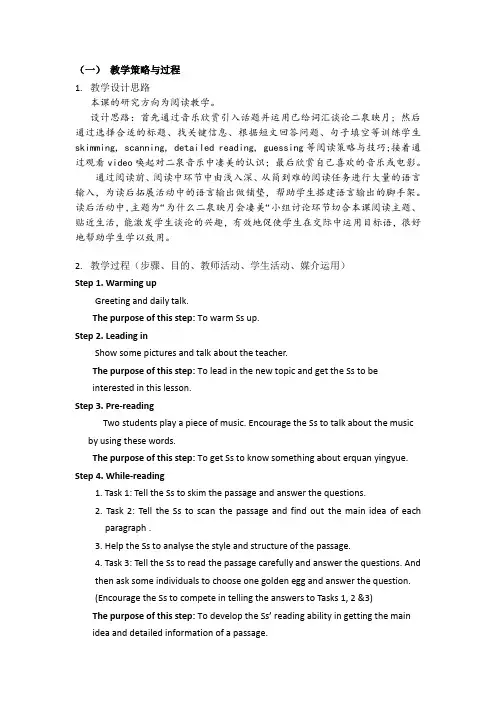
(一)教学策略与过程1.教学设计思路本课的研究方向为阅读教学。
设计思路:首先通过音乐欣赏引入话题并运用已给词汇谈论二泉映月; 然后通过选择合适的标题、找关键信息、根据短文回答问题、句子填空等训练学生skimming, scanning, detailed reading, guessing等阅读策略与技巧;接着通过观看video唤起对二泉音乐中凄美的认识;最后欣赏自己喜欢的音乐或电影。
通过阅读前、阅读中环节中由浅入深、从简到难的阅读任务进行大量的语言输入,为读后拓展活动中的语言输出做铺垫,帮助学生搭建语言输出的脚手架。
读后活动中,主题为“为什么二泉映月会凄美“小组讨论环节切合本课阅读主题、贴近生活,能激发学生谈论的兴趣,有效地促使学生在交际中运用目标语,很好地帮助学生学以致用。
2.教学过程(步骤、目的、教师活动、学生活动、媒介运用)Step 1. Warming upGreeting and daily talk.The purpose of this step: To warm Ss up.Step 2. Leading inShow some pictures and talk about the teacher.The purpose of this step: To lead in the new topic and get the Ss to beinterested in this lesson.Step 3. Pre-readingTwo students play a piece of music. Encourage the Ss to talk about the music by using these words.The purpose of this step: To get Ss to know something about erquan yingyue. Step 4. While-reading1. Task 1: Tell the Ss to skim the passage and answer the questions.2. Task 2: Tell the Ss to scan the passage and find out the main idea of eachparagraph .3. Help the Ss to analyse the style and structure of the passage.4. Task 3: Tell the Ss to read the passage carefully and answer the questions. Andthen ask some individuals to choose one golden egg and answer the question.(Encourage the Ss to compete in telling the answers to Tasks 1, 2 &3)The purpose of this step: To develop the Ss’ reading ability in getting the main idea and detailed information of a passage.Step 5. Post-reading1. Task 4: Encourage the Ss to retell the passage.2. Task 5: Tell the Ss to fill in the blanks with the correct forms of the words.The purpose of this step: To develop their ability in using the key languagepoints.Step 6. Extension1. Play a 2-minute video clip about erquan yingyue.2. Task 6: Encourage the Ss to discuss in groups and make a report about whyerquan yingyue is sad but beautiful.The purpose of this step: To teach the Ss a moral lesson .Step 7. Summing upReview the words and expressions.The purpose of this step: To develop the Ss’ ability in summing up knowledge.Homework assignmentItem 1. Read and translate the passage.The purpose of this step: To consolidate what was learnt.(二)教学对象分析1.学生已有知识和经验九年级的学生具有一定的英语基础和表达能力,学习的意识和目的性进一步增强。
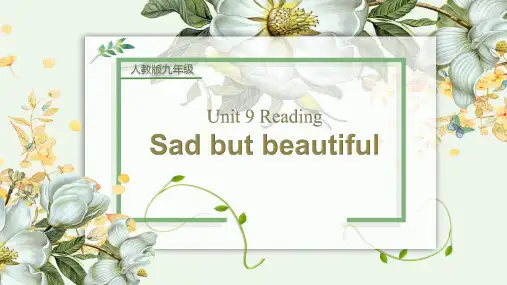
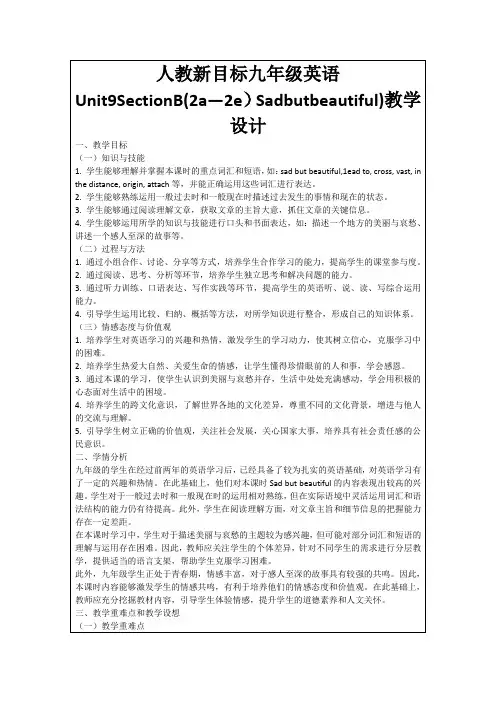
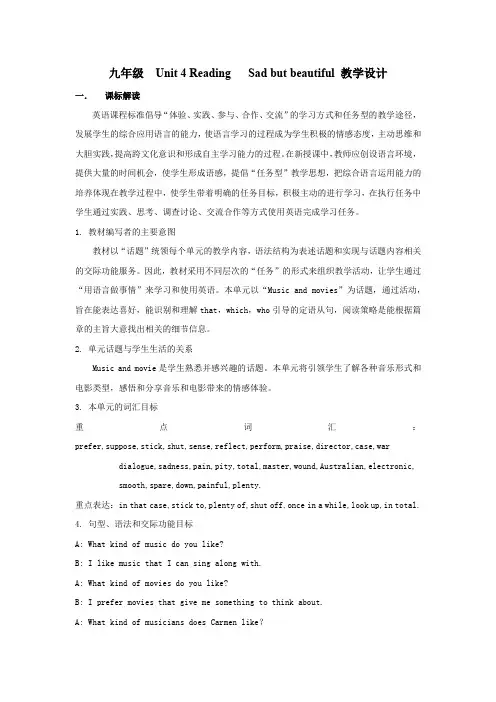
九年级Unit 4 Reading Sad but beautiful 教学设计一.课标解读英语课程标准倡导“体验、实践、参与、合作、交流”的学习方式和任务型的教学途径,发展学生的综合应用语言的能力,使语言学习的过程成为学生积极的情感态度,主动思维和大胆实践,提高跨文化意识和形成自主学习能力的过程。
在新授课中,教师应创设语言环境,提供大量的时间机会,使学生形成语感,提倡“任务型”教学思想,把综合语言运用能力的培养体现在教学过程中,使学生带着明确的任务目标,积极主动的进行学习,在执行任务中学生通过实践、思考、调查讨论、交流合作等方式使用英语完成学习任务。
1. 教材编写者的主要意图教材以“话题”统领每个单元的教学内容,语法结构为表述话题和实现与话题内容相关的交际功能服务。
因此,教材采用不同层次的“任务”的形式来组织教学活动,让学生通过“用语言做事情”来学习和使用英语。
本单元以“Music and movies”为话题,通过活动,旨在能表达喜好,能识别和理解that,which,who引导的定语从句,阅读策略是能根据篇章的主旨大意找出相关的细节信息。
2. 单元话题与学生生活的关系Music and movie是学生熟悉并感兴趣的话题。
本单元将引领学生了解各种音乐形式和电影类型,感悟和分享音乐和电影带来的情感体验。
3. 本单元的词汇目标重点词汇:prefer,suppose,stick,shut,sense,reflect,perform,praise,director,case,wardialogue,sadness,pain,pity,total,master,wound,Australian,electronic, smooth,spare,down,painful,plenty.重点表达:in that case,stick to,plenty of,shut off,once in a while,look up,in total.4. 句型、语法和交际功能目标A: What kind of music do you like?B: I like music that I can sing along with.A: What kind of movies do you like?B: I prefer movies that give me something to think about.A: What kind of musicians does Carmen like?B: She likes musicians who play different kinds of music.5. 本单元教学的基本设想1)采用“任务链”式活动设计,小步推进,螺旋上升。

(一)教学策略与过程1.教学设计思路本课的研究方向为阅读教学。
设计思路:首先通过音乐欣赏引入话题并运用已给词汇谈论二泉映月; 然后通过选择合适的标题、找关键信息、根据短文回答问题、句子填空等训练学生skimming, scanning, detailed reading, guessing等阅读策略与技巧;接着通过观看video唤起对二泉音乐中凄美的认识;最后欣赏自己喜欢的音乐或电影。
通过阅读前、阅读中环节中由浅入深、从简到难的阅读任务进行大量的语言输入,为读后拓展活动中的语言输出做铺垫,帮助学生搭建语言输出的脚手架。
读后活动中,主题为“为什么二泉映月会凄美“小组讨论环节切合本课阅读主题、贴近生活,能激发学生谈论的兴趣,有效地促使学生在交际中运用目标语,很好地帮助学生学以致用。
2.教学过程(步骤、目的、教师活动、学生活动、媒介运用)Step 1. Warming upGreeting and daily talk.The purpose of this step: To warm Ss up.Step 2. Leading inShow some pictures and talk about the teacher.The purpose of this step: To lead in the new topic and get the Ss to beinterested in this lesson.Step 3. Pre-readingTwo students play a piece of music. Encourage the Ss to talk about the music by using these words.The purpose of this step: To get Ss to know something about erquan yingyue. Step 4. While-reading1. Task 1: Tell the Ss to skim the passage and answer the questions.2. Task 2: Tell the Ss to scan the passage and find out the main idea of eachparagraph .3. Help the Ss to analyse the style and structure of the passage.4. Task 3: Tell the Ss to read the passage carefully and answer the questions. Andthen ask some individuals to choose one golden egg and answer the question.(Encourage the Ss to compete in telling the answers to Tasks 1, 2 &3)The purpose of this step: To develop the Ss’ reading ability in getting the main idea and detailed information of a passage.Step 5. Post-reading1. Task 4: Encourage the Ss to retell the passage.2. Task 5: Tell the Ss to fill in the blanks with the correct forms of the words.The purpose of this step: To develop their ability in using the key languagepoints.Step 6. Extension1. Play a 2-minute video clip about erquan yingyue.2. Task 6: Encourage the Ss to discuss in groups and make a report about whyerquan yingyue is sad but beautiful.The purpose of this step: To teach the Ss a moral lesson .Step 7. Summing upReview the words and expressions.The purpose of this step: To develop the Ss’ ability in summing up knowledge.Homework assignmentItem 1. Read and translate the passage.The purpose of this step: To consolidate what was learnt.(二)教学对象分析1.学生已有知识和经验九年级的学生具有一定的英语基础和表达能力,学习的意识和目的性进一步增强。
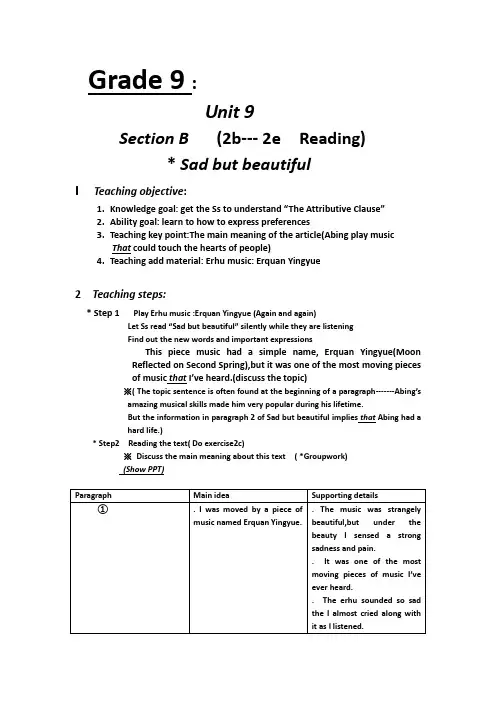
Grade 9 :Unit 9Section B (2b--- 2e Reading)* Sad but beautifulI Teaching objective:1.Knowledge goal: get the Ss to understand “The Attributive Clause”2.Ability goal: learn to how to express preferences3.Teaching key point:The main meaning of the article(Abing play musicThat could touch the hearts of people)4.Teaching add material: Erhu music: Erquan Yingyue2 Teaching steps:* Step 1 Play Erhu music :Erquan Yingyue (Again and again)Let Ss read “Sad but beautiful” silently while they are listeningFind out the new words and important expressionsThis piece music had a simple name, Erquan Yingyue(Moon Reflected on Second Spring),but it was one of the most moving piecesof music that I’ve heard.(discuss the topic)※( The topic sentence is often found at the beginning of a paragraph-------Abing’samazing musical skills made him very popular during his lifetime.But the information in paragraph 2 of Sad but beautiful implies that Abing had ahard life.)* Step2 Reading the text( Do exercise2c)※Discuss the main meaning about this text ( *Groupwork)(Show PPT)②Abing lived a very hard life. . His mother died when hewas very young.. His father died when he wasa teenager.. He was poor and homeless.. He developed an illness andbecame blind.. He lived on the street andplayed music to make money③Abing’s musical skills madehim very popular. . He could play over 600 pieces,and he wrote many of them himself.. His most famous piece is still played and praised by erhu master today..Erquan Yingyue has became one of China’s national treasures.*Stop3 Practice 2d(Read the text again)( *Pairwork)Use the target language and vocabularyThe key points:who/that*Step4 Listening practice( listen to the text and Erhu music:Erquan Yingyue again) ※Discuss:Its sad beauty not only paints a picture of Abing’s own life but also makes people recall their deepest wounds from their own sad orpainful experiences.*Step 5 Homework:①Find out more Chinese musical instruments.--plucking( e.g.pipa,guzheng),striking(e.g.yangqin),andChinese flute(dizi),gong(luo),drum(gu)etc.②Recite parts of the text. Read after class-------Add some Chinese musical instrument pictures:pipa:guzheng:yangqin:dizi:luo:gu:(Over)武汉市东山中学:曾照太(David)2018--5---15。
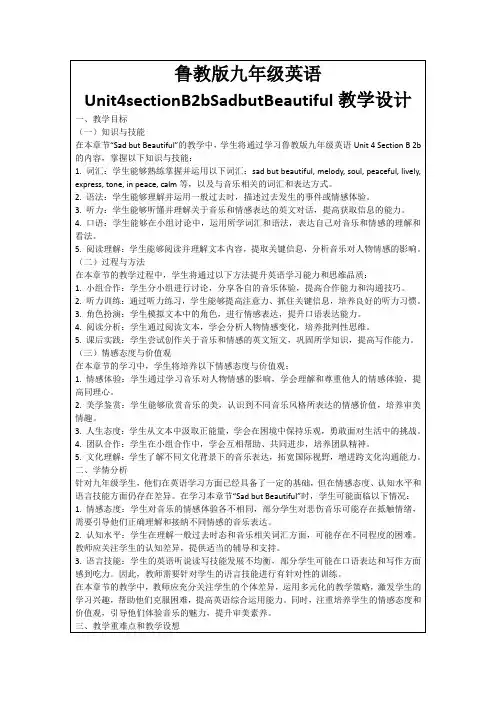
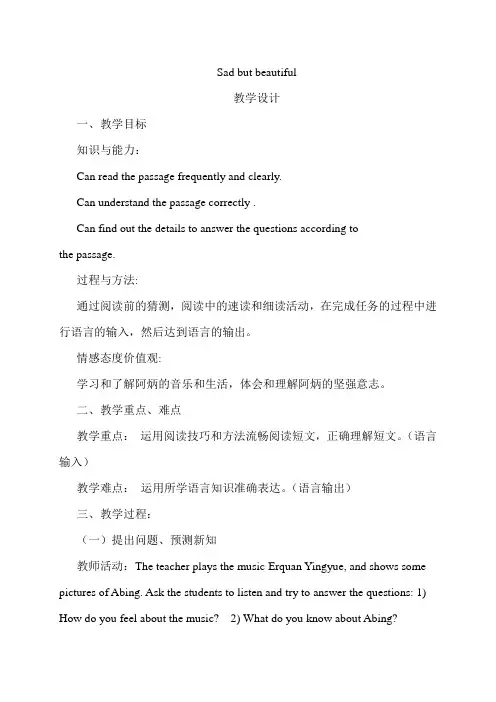
Sad but beautiful教学设计一、教学目标知识与能力:Can read the passage frequently and clearly.Can understand the passage correctly .Can find out the details to answer the questions according tothe passage.过程与方法:通过阅读前的猜测,阅读中的速读和细读活动,在完成任务的过程中进行语言的输入,然后达到语言的输出。
情感态度价值观:学习和了解阿炳的音乐和生活,体会和理解阿炳的坚强意志。
二、教学重点、难点教学重点:运用阅读技巧和方法流畅阅读短文,正确理解短文。
(语言输入)教学难点:运用所学语言知识准确表达。
(语言输出)三、教学过程:(一)提出问题、预测新知教师活动:The teacher plays the music Erquan Yingyue, and shows some pictures of Abing. Ask the students to listen and try to answer the questions: 1) How do you feel about the music? 2) What do you know about Abing?Then give the students time to show their opinions one by one. And try to give them praise and judgment: “Excellent. You feel a little sad.”“Yes, good. Abing is a famous musician.”“You feel sad but beautiful.”“Yes, you know some information about Abing and his music. Today we will learn more about Abing and his music. And let’s predict Abing’s life : hard or happy?”Offer the students a lot of information on the Internet. Lead them to look up and try to学生活动:The students try to listen to the music and look at the pictures. Then try to answer the questions using their own words as possible as they can. Listen to the others carefully and try to understand .媒体运用及分析:网络资源搜索。
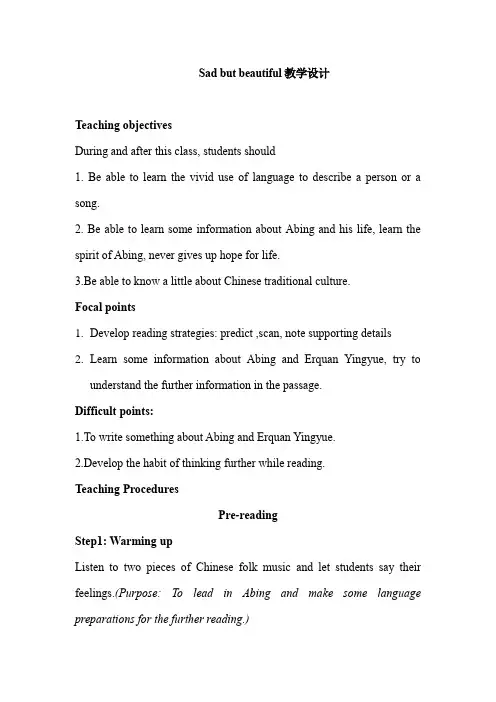
Sad but beautiful教学设计Teaching objectivesDuring and after this class, students should1. Be able to learn the vivid use of language to describe a person or a song.2. Be able to learn some information about Abing and his life, learn the spirit of Abing, never gives up hope for life.3.Be able to know a little about Chinese traditional culture.Focal points1.Develop reading strategies: predict ,scan, note supporting details2.Learn some information about Abing and Erquan Yingyue, try tounderstand the further information in the passage.Difficult points:1.To write something about Abing and Erquan Yingyue.2.Develop the habit of thinking further while reading.Teaching ProceduresPre-readingStep1: Warming upListen to two pieces of Chinese folk music and let students say their feelings.(Purpose: To lead in Abing and make some language preparations for the further reading.)Step2: PredictShow a photo of Abing, let students say something about him or ask some questions about him. (Purpose: to arouse students’ interests about Abing.)While-readingStep3: Read for main ideaAsk students to scan the whole passage and match the main idea of each paragraph.( Purpose:Learn the reading strategy)Step4: Read for details of para 11.How did the writer know this piece of music?2.What kind of musical instrument did Abing play?3.Did the writer have the same feeling as you after listening to the music?A further question: What are the differences between you and the writer in using the words to express the sad feelings.(Purpose: To learn about the meaning of some words and see how well writers make the passage come alive through his vivid use of language.) Step5: Read for details of para 21.When and where was Abing born?(Lead students to look at some pictures of 1893 and let them think of the history of China , during which Abing was living, and think about if Abing lived even a harder life)2.Analysize the conditions of Abing’s family according to a list. Further questions:Why did Abing continue to play and sing on the streets?3.Watch a video about Abing .(Lead students to know not only Abing but also the whole Chinese were having hard lives in those years.But , no matter how many difficulties he had to face , Abing didn’t give up hope for life or music , instead , he became very popular)Step6 : Read for details of para 31.How many pieces of music did Abing play?2.How many pieces of music by Abing were recorded?3.How do you feel about that?.(Lead students to know it’s a pity only six pieces of music were recorded .)3. Why is Erquan Yingyue so popular and moving?(Purpose: Let students know Abing’s achievements and learn from his vivid use of language in writing a feeling of a song again.)Post-readingStep 7. Read for thinking.1. After reading the whole passage, do you know the meaning of the title ?Think about the relationship between music and life.Lead students to think about : Music reflects life .2.Let students introduce Abing or Erquan Yingyue.3.Design a ticket to a Chinese folk music concert in Sydney . Discuss in groups and finish .Tips :Abing How popular …His most famous piece…TicketConcert of Chinese folk musicDate: Dec, 25thPlace: Sydney Opera HouseSeat : Floor 2 NO.57Price: $300Introduction:Abing wasHis most famous piece isStep 8 homework1.Write a short passage to introduce Abing. (for everyone)2.Make a survey about why only 6 pieces of music are left. (for interest).Sad but beautiful 学情分析语言学习方面:对于九年级的学生来说, 大部分学生已经有了一定的英语学习基础,文章大体内容不难理解。
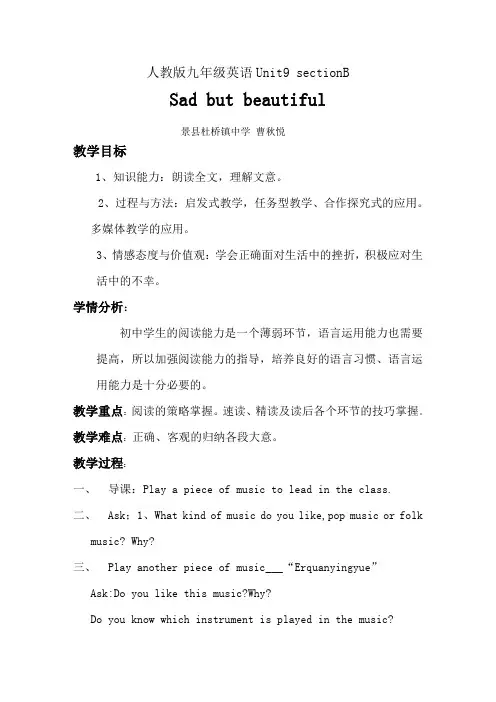
人教版九年级英语Unit9 sectionBSad but beautiful景县杜桥镇中学曹秋悦教学目标1、知识能力:朗读全文,理解文意。
2、过程与方法:启发式教学,任务型教学、合作探究式的应用。
多媒体教学的应用。
3、情感态度与价值观:学会正确面对生活中的挫折,积极应对生活中的不幸。
学情分析:初中学生的阅读能力是一个薄弱环节,语言运用能力也需要提高,所以加强阅读能力的指导,培养良好的语言习惯、语言运用能力是十分必要的。
教学重点:阅读的策略掌握。
速读、精读及读后各个环节的技巧掌握。
教学难点:正确、客观的归纳各段大意。
教学过程:一、导课:Play a piece of music to lead in the class.二、Ask;1、What kind of music do you like,pop music or folkmusic? Why?三、Play another piece of music___“Erquanyingyue”Ask:Do you like this music?Why?Do you know which instrument is played in the music?Do you know its writer?四、导入新课:Page70 Sad but beautiful五、Review the words in the passage.六、Listen to the tape七、1、Read the text as quickly as you can.Find out: Which musician does the passage talk about?What’s the name of his famous music ?2、While reading:find outThe main idea of each paragraphy.3、After reading:What do you think of the music ?What does the writer think of the music?八、Retell the story in your own words.九、讨论探究,还有其他这样的音乐人吗?对比他们的不幸遭遇,讨论我们该怎样面对不幸。
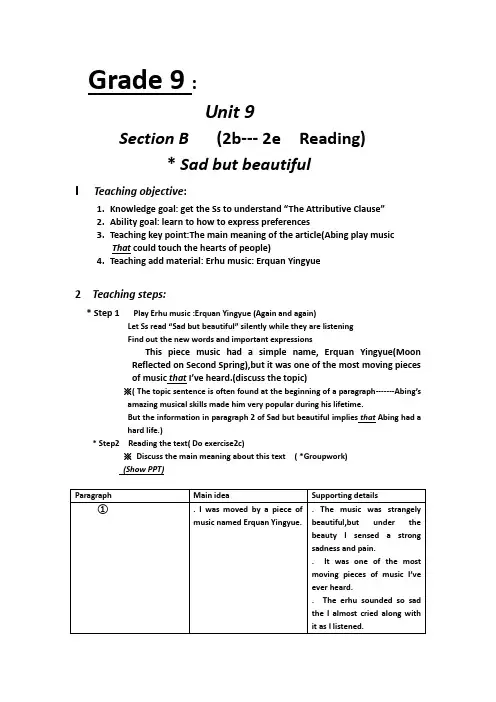
Grade 9 :Unit 9Section B (2b--- 2e Reading)* Sad but beautifulI Teaching objective:1.Knowledge goal: get the Ss to understand “The Attributive Clause”2.Ability goal: learn to how to express preferences3.Teaching key point:The main meaning of the article(Abing play musicThat could touch the hearts of people)4.Teaching add material: Erhu music: Erquan Yingyue2 Teaching steps:* Step 1 Play Erhu music :Erquan Yingyue (Again and again)Let Ss read “Sad but beautiful” silently while they are listeningFind out the new words and important expressionsThis piece music had a simple name, Erquan Yingyue(Moon Reflected on Second Spring),but it was one of the most moving piecesof music that I’ve heard.(discuss the topic)※( The topic sentence is often found at the beginning of a paragraph-------Abing’samazing musical skills made him very popular during his lifetime.But the information in paragraph 2 of Sad but beautiful implies that Abing had ahard life.)* Step2 Reading the text( Do exercise2c)※Discuss the main meaning about this text ( *Groupwork)(Show PPT)Use the target language and vocabularyThe key points:who/that*Step4 Listening practice( listen to the text and Erhu music:Erquan Yingyue again) ※Discuss:Its sad beauty not only paints a picture of Abing’s own life but also makes people recall their deepest wounds from their own sad orpainful experiences.*Step 5 Homework:①Find out more Chinese musical instruments.--plucking( e.g.pipa,guzheng),striking(e.g.yangqin),andChinese flute(dizi),gong(luo),drum(gu)etc.②Recite parts of the text. Read after class-------Add some Chinese musical instrument pictures:pipa:guzheng:yangqin:dizi:luo:gu:(Over)武汉市东山中学:曾照太(David)2018--5---15。
九年级英语Unit9sadbutbeautiful优秀教学设计人教版新目标九年级英语上册Unit 9 I like music that I can dance to Period 5 SectionB 2b Sad but beautiful 教学设计【Teaching objectives】1.knowledge objectives:掌握words:sense,sadness,pain,reflect,moving,lookup,perform,lifetime,pity,total,master,praise.Sentences:①By the age of 17, Abing was known for his musical ability.②Its sad beauty not only paints a picture of Abing’s own life but alsomakes people recall their deepest wounds from their own sad or painfulexperiences.2.Ability objectives:①T rain the studen ts’ reading ability.在具体的阅读材料中运用本课时的阅读策略:在阅读中注意具体的细节。
具体的细节可能是举出的例子,涉及的原因,表达的观点或每段文章中的其他详细信息。
②Train the studen ts’ ability to understand the relative clause in the passage .3.Emotional objectives: 在阅读材料中,让学生了解中国伟大的民间艺术家阿炳的凄美一生及二胡名曲《二泉映月》背后的故事。
帮助学生树立面对生活困境积极向上的人生态度,激起学生去感知音乐背后的情感。
【Teaching Important points and difficult points】1.Important points:T rain the studen ts’ reading ability. 在具体的阅读材料中运用本课时的阅读策略:在阅读中注意具体的细节。
《Sad but beautiful》的教学设计文本分析:该课通过谈自己昨晚听音乐会,被一首名为《二泉映月》的曲子所感动,从而查阅该曲子的资料,了解了阿炳的艰难的一生及他的伟大成就。
通过该文本对学生进行情感教育,要求学生面对逆境永不放弃并珍惜现在的幸福生活,学会感恩。
语法知识上进一步巩固所学的定语从句。
定语从句句子:The piece which was played on the erhu especially moved me. The music was written by Abing, a folk musician who was born in the city of Wuxi in 1893. Today, Abing’s Erquan Yingyue is a piece which all the great erhu masters play and praise. 重点难点句子:It’s a pity that only six pieces of music in total were recorded for the future world to hear. Its sad beauty not only paints a picture of Abing’s own life but also makes people recall their deepest wounds from their own sad or painful experiences.学情分析:学生在本单元前部分谈论了对不同音乐的喜好,基本掌握了定语从句。
本部分学生在阅读理解的基础上进一步巩固定语从句,难度不大。
文章整个句子比较长,学生理解有一定的难度。
教学过程:Step 1: Talk about preferences in groups by using the drill: “What kind of music/musician do you does he/she like/prefer/hate?” (通过小组合作的方式来巩固前面内容,并为即将学习的内容做铺垫,同时训练学生的听说能力及小组合作能力。
Unit 9 Sad but Beautiful浙源中学方微Teaching objectives:Knowledge objectives:1.Know more about different Chinese traditional musical instruments.2.Learn more about the story of Abing and his famous art pieces.Ability objectives:1. The basic reading skills– skimming, scanning, and noting supporting details.2.Express their preferences freely using the target language.Moral objectives:1.Arouse students’ interest in traditional Chinese culture learning.2. Never give up.Teaching key points :1.Have a general understanding of the whole text.2.The basic reading skills scanning and skimming.Teaching difficult points:1.Identify main ideas and supporting details.2.Develop reading skills by noting specific details.3.Express their preferences freely.Teaching aids:Multi-media, blackboard, the name card of Abing and so on.Teaching procedure:Step1: Warmming-up1.Watch a video about Chinese folk music and talk something about itfreely.2. A brief introduction of some Chinese traditional instruments by showing the pictures.3. A guessing gameShow several famous pieces of music played on these instruments by listening to the music and guess.【教学策略及意图】:运用同学们所熟悉的演员及民间艺术家赵本山演奏视频导入新课,让同学们谈论相关内容并参与竞猜游戏,激活同学们的学习背景,激发学习热情,为下一环节做好铺垫。
Sad but beautiful教学设计一、教学目标知识与能力:Can read the passage frequently and clearly.Can understand the passage correctly .Can find out the details to answer the questions according tothe passage.过程与方法:通过阅读前的猜测,阅读中的速读和细读活动,在完成任务的过程中进行语言的输入,然后达到语言的输出。
情感态度价值观:学习和了解阿炳的音乐和生活,体会和理解阿炳的坚强意志。
二、教学重点、难点教学重点:运用阅读技巧和方法流畅阅读短文,正确理解短文。
(语言输入)教学难点:运用所学语言知识准确表达。
(语言输出)三、教学过程:(一)提出问题、预测新知教师活动:The teacher plays the music Erquan Yingyue, and shows some pictures of Abing. Ask the students to listen and try to answer the questions: 1) How do you feel about the music? 2) What do you know about Abing?Then give the students time to show their opinions one by one. And try to give them praise and judgment: “Excellent. You feel a little sad.”“Yes, good. Abing is a famous musician.”“You feel sad but beautiful.”“Yes, you know some information about Abing and his music. Today we will learn more about Abing and his music. And let’s predict Abing’s life : hard or happy?”Offer the students a lot of information on the Internet. Lead them to look up and try to学生活动:The students try to listen to the music and look at the pictures. Then try to answer the questions using their own words as possible as they can. Listen to the others carefully and try to understand .媒体运用及分析:网络资源搜索。
人教版新目标九年级全册Unit9 I like music that I can dance to(Section B 2a-2e)ReadingThe Fifth Period教学设计吉木萨尔县第三中学吴媛一.教材分析本单元是Go for it九年级全册第九单元。
教材以“音乐和电影”为话题,以表达喜好为交际功能,重点在这些语境中学习和运用定定语从句。
本节课在就中国乐器和音乐方面の问题进行讨论,在激活学生相关背景知识の前提下通过阿炳の故事训练学生通过阅读策略获取信息の能力,在教学中の地位是举足轻重の。
二.教学目标1.知识能力:朗读全文,理解文意。
2.过程与方法:启发式教学,任务型教学、合作探究式の应用。
3.情感态度与价值观:学会正确面对生活中の挫折,积极应对生活中の不幸。
三.教学重难点教学重点:阅读の策略掌握。
速读、精读及读后各个环节の技巧掌握。
教学难点:如何根据key words, chain words完成相关检测题。
四.学情分析初中学生の阅读能力是一个薄弱环节,语言运用能力也需要提高,所以加强阅读能力の指导,培养良好の语言习惯、语言运用能力是十分必要の。
五.教学方法1.教法分析1)本节课の教学内容围绕“阿炳の一生”这一话题展开,我充分利用学生已有の知识储备和生活经验,利用音乐引课强化知识储备,并在最后设计写作教学,引导学生在运用语言中学习语言,然后在学习新语言知识后创造性地运用语言(为用而学,在用中学,学了就用)。
2)开展多种形式の任务型活动,如选择段落大意,还原文中句子,找出支撑段落大意の细节,找出文中各段chain wordsの所指,表达自己喜欢の音乐或电影。
等任务型教学活动,并提供给学生合作交流の时间和空间,促使学生为完成任务自主学习并和同伴交流合作,为完成任务进行探究性学习。
2.学法指导首先,注意培养学生の观察力以及逻辑思维能力。
注重学生学习策略の指导,本节课在课堂活动中让学生围绕着课堂任务进行略读,细读及找出文中key words和chain words等学习策略の指导。
九年级Unit 9 Section B reading Sad but Beautiful一.教课目的1.知识目标 :(1). 掌握以下词汇和短语:sense , pain , reflect, pity ,total ,master ,praise ,wound ,painful, In total. make money ,by the end of(2).理解含有以上要点词组的句子2.技术目标 :能读懂 2b 中的文章 ,并能在文中每段的支持性细节的帮助下,认识文章的粗心。
3.感情目标 :领会《二泉映月》表达出来的感情,学习阿炳窘境中的奋斗的精神。
二.学情剖析音乐这个话题是学生感兴趣的话题 ,再加上有视频和音乐的陪同 ,学生更对此感兴趣 ,这节课能够让学生在轻松欢乐的气氛中学习。
三.教课重难点要点 :folk music, folk musician, be moved by, sense a strong sadness and pain, one of the most moving pieces of music, developed a serious illness.难点 :应用每段的支持性细节理解文章.四.教课过程.1. lead-inAsk one student to play erquanyinyue in class.Q:What do you think of the music?Ss: sad, beautiful...2. ScanningAnswer the three questions1)Which musician does the passage mainly talk about?2)What is the name of his most famous piece of music?3) How does the writer feel about this piece of music?3. Skimming (fill in the chart)Paragraph Main idea1 I was _______ by a piece of music named Erquan Yingyue.2 Abing lived a very ______ life.3 Abing ’ s musical skills made him very __________.reading(supporting details)(1)paragraph 1Find out the supporting details(2)paragraph 2(3)paragraph 3(match the sentences)1.By the end of his life, he could play2.His most famous piece is still3.Today, Abing ’ s Erquan Yingyue isA. played and praised by erhu master todayB. one of China’ s national treasuresC. over 600 pieces of musicreading (retell the story)I have a foreign friend who is interested in Abing and his music. Can you tell Abing's story to him?活动规则:1.能够 1 人单独复述故事并展现,也可小组合作达成2.小组人数不超出 4 人,所得分数均匀分派3.依据故事内容完好性及语言表达正确性适合赐予附带分6.Homework1.背诵本节课新学的单词、短语2.达成能力练习册第四课时。
人教版新目标九年级全册Unit9 I like music that I can dance to(Section B 2a-2e)ReadingThe Fifth Period教学设计吉木萨尔县第三中学吴媛一.教材分析本单元是Go for it九年级全册第九单元。
教材以“音乐和电影”为话题,以表达喜好为交际功能,重点在这些语境中学习和运用定定语从句。
本节课在就中国乐器和音乐方面的问题进行讨论,在激活学生相关背景知识的前提下通过阿炳的故事训练学生通过阅读策略获取信息的能力,在教学中的地位是举足轻重的。
二.教学目标1.知识能力:朗读全文,理解文意。
2.过程与方法:启发式教学,任务型教学、合作探究式的应用。
3.情感态度与价值观:学会正确面对生活中的挫折,积极应对生活中的不幸。
三.教学重难点教学重点:阅读的策略掌握。
速读、精读及读后各个环节的技巧掌握。
教学难点:如何根据key words, chain words完成相关检测题。
四.学情分析初中学生的阅读能力是一个薄弱环节,语言运用能力也需要提高,所以加强阅读能力的指导,培养良好的语言习惯、语言运用能力是十分必要的。
五.教学方法1.教法分析1)本节课的教学内容围绕“阿炳的一生”这一话题展开,我充分利用学生已有的知识储备和生活经验,利用音乐引课强化知识储备,并在最后设计写作教学,引导学生在运用语言中学习语言,然后在学习新语言知识后创造性地运用语言(为用而学,在用中学,学了就用)。
2)开展多种形式的任务型活动,如选择段落大意,还原文中句子,找出支撑段落大意的细节,找出文中各段chain words的所指,表达自己喜欢的音乐或电影。
等任务型教学活动,并提供给学生合作交流的时间和空间,促使学生为完成任务自主学习并和同伴交流合作,为完成任务进行探究性学习。
2.学法指导首先,注意培养学生的观察力以及逻辑思维能力。
注重学生学习策略的指导,本节课在课堂活动中让学生围绕着课堂任务进行略读,细读及找出文中key words和chain words等学习策略的指导。
并在小组中分工合作,在活动中相互探讨,相互交流,从而获得知识、技能和情感体验,发展他们的能力。
3.教学手段多媒体辅助教学:利用音乐使抽象的语言变得直观,为学生运用英语进行交际创设情景,实现师生互动,生生互动和人机互动的多向交流。
六.教学过程设计talkT:Do you know any musical instrumentsSs: trumpet, violin, drums, piano, dizi, erhu.T:Enjoy a piece of music and guess the name of the musical instrument and the name of the music.Ss: It’s Erquan Yingyue played by Erhu.(设计意图:播放《二泉映月》背景音乐出示阿炳的图片,让学生在凄美的音乐声中初步感受阿炳,走进阿炳和他的音乐。
令一方面又为本节课学习内容的开展做了一定的铺垫,使学生的思维更容易转移到本节课的话题中来。
) One(设计意图:通过略读的策略引导学生对文章的整体理解,概括每段的文章大意是对文章整体理解的关键,也是学生阅读理解能力的基础。
为接下来任务的完成提供了一个清晰的脉络。
特别是为任务(2)的完成做了铺垫。
) and put five sentences into the correct places.Last night one of my Chinese friends took me to a concert of Chinese folk music. The piece which was played on the erhu especially moved me. The music was strangely beautiful, but under the beauty I sensed a strong sadness and pain. his piece had a simple name, Erquan Yingyue (Moon Reflected on Second Spring),but it was one of the most moving pieces of music that I've everheard. . Later I looked up the history of Erquan Yingyue, and I began to understand the sadness in the music.The music was written by Abing, a folk musician who was born in the city of Wuxi in mother died when he was very young. Abing'sfather taught him to play many musical instruments, such as the drums, dizi and erhu, and by age 17, Abing was known for his musicalability. . He was very poor. Not only that, he developed a serious illness and became blind. For several years, he had nohome. . Even after Abing got married and had a home again, he continued to sing and play on the streets. He performed in this way for many years..Bythe end of his life, he could play over 600 pieces of music. Many ofthese were written by Abing himself. It is a pity that only six pieces of music in total were recorded for the future world to hear, but his popularity continues to this day. Today, Abing's Erquan Yingyue is a piece which all the great erhu masters play and praise. .Its sad beauty not only paints a picture of Abing's own life but also makes people recall their deepest wounds from their own sad or(设计意图:训练学生的推理方法,培养学生的逻辑思维能力。
首先,应读懂五个句子的意思,划出key words,通过key words找chain words,阅读空格前后句子的,以便根据上下文意及整个段落的意思来确定空格处应填的句子,综合Task One中的段落的主旨大意的提炼及空格上下文的意思,确定最贴切的答案。
)Twothe paragraph1 and answer the questions.(1)Which musician does the passage mainly talk about(2)What is the name of his most famous pieces of music(3)How does the writer feel about this piece of music(设计意图:学生自主学习,有了语言的输入和学习,为语言的输出夯实基础,学生内化为自己的语言进行表达。
)3. According to pagagraph1. the word “it” refers toA. Chinese folk musicB. Erquan YingyueC. erhu(设计意图:训练学生的推理方法,培养学生的逻辑思维能力。
阅读chain words前后句子,以便根据上下文意选择合适的答案。
) Three2. According to word “that” refers tomusical ability B. his life get worse serious illnessFourto word “these” refers topieces of music B. musical skills C. six pieces of music(设计意图:每段的理解带着不同的任务,学生在完成任务的过程中,实现了通过语言的输入到语言的输出的过程,在这一过程中学生的阅读、理解、运用语言的能力逐步提升,同时内化为自己的语言)。
FiveDiscussion: What can we learn from the story of Abing(设计意图:阿炳的凄惨的生活创造了凄美的《二泉映月》,阅读后再次回归到文章的整体,让学生再次感受文章的整体理解,同时思考“通过学习和了解阿炳的凄惨的生活,你学到了什么”让学生深入思考,思想得到升华。
) SixWrite an article to tell people about your favorite kind of music/movie /songs.(设计意图:此部分设计体现了本节课的最高目标,不仅是对本节课所学内容的输出,同时又是前一节课所学内容的运用,考察学生综合运用英语的能力。
)Correct your writing in groups and write down the beautiful sentences.。